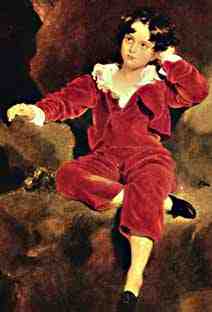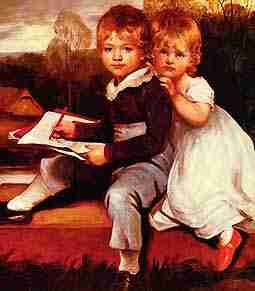
Skeleton Suits: Styles

Figure 1.--This English boy wears a classic skeleton suit in a scene
painted at about the turn of the century. Notice the open collar with
elaborate ruffles, repeated at the wrist. His burgandy suit may have
been more common than the bright red ones. Note he wears a one-piece
suit. but has a matching jacket. His pantaloons are not as tight as many
other boys wore with skeleton suits.
|
Skeleton suits appeared in one-piece and two-piece styles. The one-piece suits were rather like jumper outfit with the jacket and trousers combined in one front buttoning outfit. Such suits jumpers might be made of brown linen or kerseymere white cambric. As they were for younger boys there were generally white frills at the collar and even the ankles as young boys might wear pantalettes. Both styles had many of the same fashion features such as high waists and numerous buttons in necesary and many unnecessary places. While there are many versions of skeleton suits with a great variety of stylistic variations, there are still only these two basic styles. The English novelist Charles Dickens wrote during the era in which thevskeleton suits was passing from fashion. Many of his boy characters, especially Oliver Twist and David Copperfield, wore skeleton suits. He described the fashion as "one of those straight blue cloth cases in which small boys used to be confined ... fastening him into a very tight jacket, with an ornamental row of buttons over each shoulder and then buttoning his trousers over it so as to give his legs the appearance of being hooked on just under the arm pits." The skeleton suit is considered by some students of clothing design to charming and artistic and periodically influences fashions, akthough not to the degree of the early 19th century. Some view it and concurret high-waist dress styles for girls as some of the most charming children's costumes ever designed. While the high waist tended to be present in all skeleton suits, other features of the suit varied over time such as collars and pants length. The skeleton suit was also a practical garment for a child. The open collar style was comfortable. The suit was generally styled with enough fullness to allow movement, but trim enough to maintain a reasonably tidy appearance.
One-piece Suits
Many of the earlier suits were one-poece suits with the jacket and
trousers combined in a sort of early 19th Century jump suit. Some of
these one-piece suits were worn with matching jackets. I'm not
precisely sure how these suits buttoned and how they were put on.
They were worn with different style blouses. Some of the blouses had
comfortable-looking open collars. Some of the jackets had high collars
buttoned tight, often with lace trim. I'm not sure if a blouse was
worn with style of one-piece suit or if the lace trim was part of trim
on the suit itself.

Figure 2.--This English boy wears a two piece skeleton suit. Often the jacket
and pants were in contrasting colors. The boy's outfit looks similar to the school uniform developed at Eton College, the first Public School uniform.
|
Two-piece Suits
The more common style of skeleton suit was the two piece version. This
involved separate jacket and trousers. The jacket and trousers could
be of the same material or color or contrasting materail and colors
could be used. A blouse,
usually white, would button on to the pantaloons. The outfit could be worn
with just a blouse without the jacket, but many had jackets as well.
The trousers worn with these suits could be extremely high-waisted, in
some cases coming half way up the boys chest, midway between the waist
and arms. Although some precurosrs were kneebreeches, the trousers were long trousers.
The classic suit had trousers at ankle length, but this varied some what.
Some lengths were above or below the ankles.
Although the two-piece styles were clearly skeleton suits they
were the recognizable precursors of the modern boys' outfit of jacket
or blazer and trousers.
Christopher Wagner
histclo@lycosmail.com
Navigate the Historic Boys' Clothing Tunic pages:
[Return to the Main skeketon suit page]
[Historical trends]
[Stylistic features]
[Skeleton suit styles]
[Garments]
[Skeleton suit accesories]
[Pantalettes]
[Stockings]
Navigate the Boys' Historical Clothing Web Site:
[Introduction]
[Chronology]
[Activities]
[Countries]
[Clothing styles]
[Biographies]
[Bibliographies]
[Activities]
[Countries]
[Contributions]
[Boys' Clothing Home]
Created: February 3, 1999
Last updated: August13, 1999



